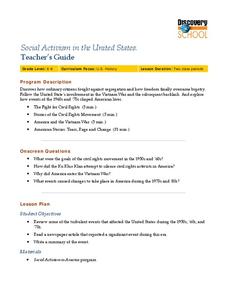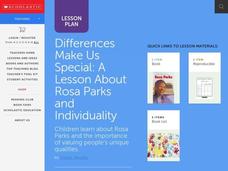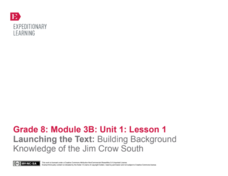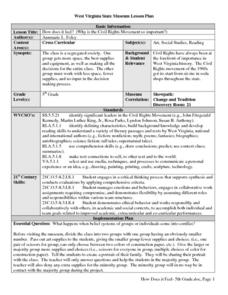Curated OER
Education as a Civil Right
Students explore the implications of segregation. For this Civil Rights lesson, students investigate what equal education is as they discover the state of Boston schools in 1960. Students define civil rights and discrimination as they...
Curated OER
Social Activism in the United States
Seventh graders explore the goals of the Civil Rights Movement of the 1950s and 1960s. In this US History lesson plan, 7th graders read a newspaper article that reported a significant event during this era. Students write a summary of...
Curated OER
The Story of Emmett Till
Students discover the story of Emmett Till. In this Civil Rights Movement lesson, students watch "Awakenings" and investigate the impact of the Emmett Till lynching. Students compose an essay that explore the lynching as a pivotal moment...
Curated OER
Dr. King and the Movement
Students complete activities about Dr. Martin Luther King's Civil Rights movements. In this Civil Rights instructional activity, students read a quote from Dr. King and discuss several questions about the topic and may use them as...
Curated OER
Mississippi Trial, 1955: K-W-H-L Strategy
To prepare for a reading of Christopher E. Crowe's Mississippi Trial, 1955, class members create a KWHL chart and begin by generating questions they have about the civil rights movement, slavery, and the death of Emmett Till.
Defining US
Integration of Education and American Society
How did the struggle for Civil Rights during the 1950s transform American society and politics? Why are American schools integrated today? Class members explore these essential questions by examining a series of primary and secondary...
Curated OER
Differences Make Us Special
Students explore the similarities and differences among their classmates. They are introduced to the Civil Rights Movement-that all people be treated equally and fairly. Students discuss the importance of appreciating individual...
Curated OER
When Youth Protest: Student Activism and the Mississippi Civil Rights Movement, 1955-1970
Students explain the meaning of the following terms associated with the modern Civil Rights movement: segregation; integration; civil rights; civil disobedience.
Curated OER
Responses to Racially Imbalanced Schools
Young scholars explore the implications of segregation. In this Civil Rights lesson, students investigate what equal education is as they discover the state of Boston schools in 1960. Young scholars define civil rights and discrimination...
Curated OER
Civil Rights Movement in America
Eleventh graders explore the Civil Rights movement as a culmination of history and cultural perspectives developed from the Slave Trade and Reconstruction. They identify leading persons and organizations and their personal philosophy to...
Stanford University
Lesson Plan: Montgomery Bus Boycott
Most of us have heard of Rosa Parks, the Montgomery Bus Boycott, and Martin Luther King, Jr. But what about Claudette Colvin, Virginia Durr, Freedom Summer, or the Birmingham Children's Crusade? A five-lesson unit prompts class members...
Mississippi Department of Archives and History
Protesting Violence without Violence
The ultimate legacy of Emmett Till's violent death is its role in the non-violent roots of the Civil Rights Movement. A instructional activity compares contemporaneous articles with the lyrics of Bob Dylan's "The Death of Emmett Till"...
PBS
The Meaning of the Fourteenth Amendment
The Fourteenth Amendment was extremely important to civil rights and is a crucial one to remember. The resource teaches about the Supreme Court decisions related to the amendment through writing exercises, reading, and working in small...
PBS
Universal Declaration of Human Rights
What rights are guaranteed to students? Do they align with the Universal Declaration of Human Rights, which was approved by the United Nations in 1948? Middle and high schoolers present persuasive arguments about the rights they believe...
Curated OER
Black Music: Its Message and Meaning
Students develop an appreciation for modern black music from a historical, political and lyrical perspective. They examine the political and the historical surge of the civil rights movement of the 1960's and how this surge directly or...
Curated OER
The Making of a Holiday: MLK, Jr. Day
Students explore the life of Martin Luther King and the Civil Rights Movement. They discuss the events surrounding his death and the significance of the federal holiday honoring Dr. King. As a class, they read about Dr. King's work for...
Curated OER
A New Generation of Fighters
Students discuss the reasons why people are less likely to take a stand on issues today than they were in the past. In groups, they research the efforts of Kings, Parks and others to end discrimination and racism. They read excerpts of...
Curated OER
Martin Luther King, Jr., and the Power of Nonviolence
Middle schoolers examine the philosophy of nonviolence developed by Martin Luther King, Jr. and how this turned into practice during the Civil Rights Movement. They compare these teachings to those of Mohandas K. Ghandi.
PBS
Jackie Robinson's Complicated — and Important — Legacy
Americans tend to lock their heroes in history, holding these icons to a particular event or time. Jackie Robinson is such a hero, remembered by most for becoming the first African American to play in the Major Leagues. Young historians...
Curated OER
Civil Rights Leaders
Tenth graders investigate three American leaders from the Civil Rights Movement while they examine the early 1960's and the topic of racial equality. They listen to music from the era, read speeches, and look at images of Martin Luther...
Curated OER
In the 1960s, Why Were Boston’s Schools Racially Segregated?
Students explore the implications of segregation. For this Civil Rights lesson, students investigate what equal education is as they discover the state of Boston schools in 1960. Students define civil rights and discrimination as they...
Curated OER
United States Colored Troops
Students explore the role that African American soldiers had in the Civil War and the impact they had on the US Civil Rights movement after the war. They complete a timeline, read an excerpt and analyze a primary image.
EngageNY
Launching the Text: Building Background Knowledge of the Jim Crow South
Pictures and photographs help build background knowledge about a topic. Scholars participate in a gallery walk to learn more about the Jim Crow era of US history and the desegregation of schools following Brown v. Board of Education....
Curated OER
How does it feel? Why is the Civil Rights Movement so Important?
Fifth graders study the Civil War. In this US history lesson, 5th graders simulate what life was like during the Civil War by having two groups with one group given more materials than the other group. Students then draw a portrait of...

























